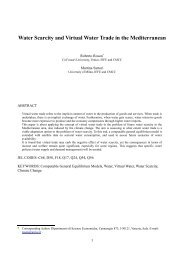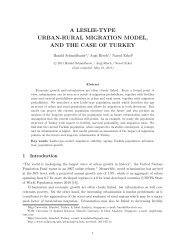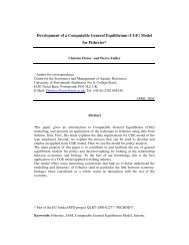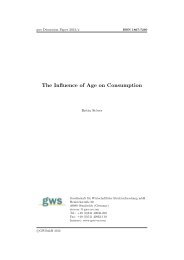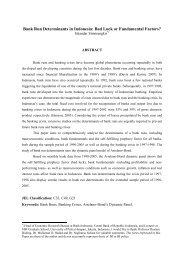Maturity Transformation and Interest Rate Risk in Large European ...
Maturity Transformation and Interest Rate Risk in Large European ...
Maturity Transformation and Interest Rate Risk in Large European ...
You also want an ePaper? Increase the reach of your titles
YUMPU automatically turns print PDFs into web optimized ePapers that Google loves.
5 ConclusionIn Section 4.1 we are able to show that large <strong>European</strong> banks tend to transform short term customerdeposits <strong>and</strong> amortised cost <strong>in</strong>struments at 1-5 year maturity like hybrid <strong>and</strong> subord<strong>in</strong>ated debt <strong>in</strong>tolong term loan assets, as expected. Given the earlier work discussed <strong>in</strong> Section 1, <strong>in</strong> which the effectivematurity of core deposits is estimated to be less than three years, the <strong>in</strong>terest rate revaluation risk ofthese banks is significantly determ<strong>in</strong>ed by their loan asset portfolios. Exam<strong>in</strong><strong>in</strong>g the loan asset valuesmore closely, we f<strong>in</strong>d <strong>in</strong> Section 2.3 that the banks with the largest loan asset porfolios <strong>in</strong> 2011 aredomiciled <strong>in</strong> the UK, France <strong>and</strong> Germany, <strong>and</strong> these banks extend loans primarily <strong>in</strong>to Euro-areacountries <strong>and</strong> then <strong>in</strong>to non-Euro <strong>European</strong> countries. Rank<strong>in</strong>g the banks by their loan asset portfoliorepric<strong>in</strong>g sensitivity to a 2% parallel shift <strong>in</strong> <strong>in</strong>terest rates <strong>in</strong> Section 4.4, we f<strong>in</strong>d that the three riskiestbanks across most methods are Nykredit (DK), SNS Bank (NL) <strong>and</strong> Espirito Santo (PT). It mustbe emphasised that these rank<strong>in</strong>gs are <strong>in</strong>dependent of balance sheet size <strong>and</strong> do not account for offbalance-sheet<strong>in</strong>struments like <strong>in</strong>terest rate derivatives, but they provide a useful start<strong>in</strong>g po<strong>in</strong>t for thebank analyst <strong>and</strong> supervisor.In measur<strong>in</strong>g the <strong>in</strong>terest rate repric<strong>in</strong>g risk of these banks, we employ several methods <strong>and</strong> criticallyevaluate the Basel Committee guidel<strong>in</strong>e method for <strong>in</strong>terest rate sensitivity. We show how thisguidel<strong>in</strong>e method is simplistic <strong>and</strong> we illustrate the size of the deviation from simple alternative pric<strong>in</strong>gmodels through the use of examples. The guidel<strong>in</strong>e method is conservative for loan <strong>in</strong>dividual loan contractswith short maturities (less than 10-15 years) <strong>and</strong> <strong>in</strong> medium-to-high <strong>in</strong>terest rate environments.However, the guidel<strong>in</strong>e method understates risk for portfolios of loans even at short maturities <strong>and</strong> for<strong>in</strong>dividual loan contracts with longer maturities, <strong>and</strong> these understatements are exacerbated <strong>in</strong> low<strong>in</strong>terest rate environments. Further work should be done to <strong>in</strong>vestigate the sensitivities of the BaselCommittee guidel<strong>in</strong>e method, <strong>and</strong> the simple alternative methods presented here for loan contracts,to the cashflow tim<strong>in</strong>g assumptions, <strong>and</strong> especially the tim<strong>in</strong>g assumption <strong>in</strong> the 5+ maturity bucket.Furthermore, we show that the 2% parallel shift <strong>in</strong> yield curves that is typically used as the socalled“st<strong>and</strong>ardised <strong>in</strong>terest rate shock” is atypical of historical Euro yield curve movements. Morework should therefore be done to determ<strong>in</strong>e the appropriate shocks to apply to <strong>in</strong>terest rates, especiallyfor supervisory purposes. In particular, it is <strong>in</strong>appropriate for supervisors to rely on monitor<strong>in</strong>g onlyone <strong>in</strong>terest rate scenario because it is fairly easy for banks to allocate their asset <strong>and</strong> liability maturitiesso that exposure to any one scenario is zero, while exposures to other scenarios might be large.ReferencesBasel Committee on Bank<strong>in</strong>g Supervision (2004): “Pr<strong>in</strong>ciples for the Management <strong>and</strong> Supervisionof <strong>Interest</strong> <strong>Rate</strong> <strong>Risk</strong>,” Discussion Paper July, Basel Committee on Bank<strong>in</strong>g Supervision, Basel,Switzerl<strong>and</strong>.Czaja, M.-G., H. Scholz, <strong>and</strong> M. Wilkens (2009): “<strong>Interest</strong> rate risk of German f<strong>in</strong>ancial <strong>in</strong>stitutions:the impact of level, slope, <strong>and</strong> curvature of the term structure,” Review of QuantitativeF<strong>in</strong>ance <strong>and</strong> Account<strong>in</strong>g, 33(1), 1–26.English, W. B., S. J. van den Heuvel, <strong>and</strong> E. Zakrajsek (2012): “<strong>Interest</strong> <strong>Rate</strong> <strong>Risk</strong> <strong>and</strong> BankEquity Valuations,” FEDS Work<strong>in</strong>g Papers, (2012-26).Entrop, O., C. Memmel, M. Wilkens, <strong>and</strong> A. Zeisler (2011): “Estimat<strong>in</strong>g the <strong>Interest</strong> <strong>Rate</strong><strong>Risk</strong> of Banks Us<strong>in</strong>g Time Series of Account<strong>in</strong>g-Based Data,” Available at SSRN 982070.Federal Deposit Insurance Corporation (1994): “The Bank<strong>in</strong>g Crises of the 1980s <strong>and</strong> Early1990s: Summary <strong>and</strong> Implications,” Discussion paper, Federal Deposit Insurance Corporation.Flannery, M., <strong>and</strong> C. M. James (1984a): “The Effect of <strong>Interest</strong> <strong>Rate</strong> Changes on the CommonStock Returns of F<strong>in</strong>ancial Institutions,” The Journal of F<strong>in</strong>ance, 39(4), 1141–1153.Flannery, M. J., <strong>and</strong> C. M. James (1984b): “Market Evidence on the Effective <strong>Maturity</strong> of BankAssets <strong>and</strong> Liabilities,” Journal of Money, Credit <strong>and</strong> Bank<strong>in</strong>g, 16(4), 435–445.Gorton, G., <strong>and</strong> R. Rosen (1995): “Banks <strong>and</strong> derivatives,” NBER Work<strong>in</strong>g Paper Series, 5100.29




